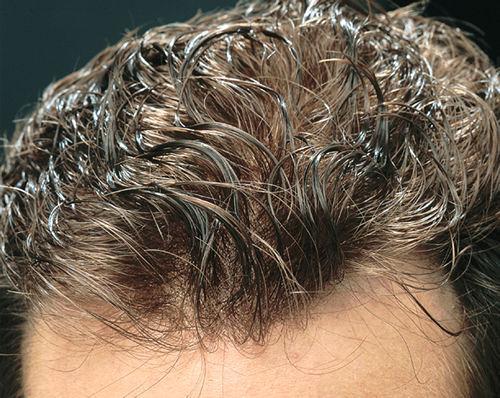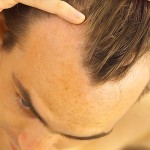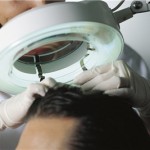26.01.2009
in HAIR LOSS SCIENCE

“A cure for baldness is one step closer after scientists found two genes that dramatically increase the chance of hair loss in men,” the Daily Express reported.
It said that tests in over 1,125 men have revealed that men who have two genetic variants are seven times more likely to lose their hair. The newspaper reports that around 14% of men carry both genetic variants, a third of men suffer from baldness by the age of 45, and 80% of cases are thought to be caused by genetic factors.
This genetics study has confirmed the association of the AR gene with male-pattern baldness (it is located on the X chromosome and therefore inherited down the female line). The study also identified a variation within chromosome 20 that also seems to be associated with the condition. However, the variations on chromosome 20 are not located within a gene (a region of DNA that contains instructions to make a protein), therefore determining how or why these genetic variants could affect male-pattern baldness requires further research. It is hoped that this discovery could lead towards new treatments for hair loss, but any potential treatments remain a long way off.
Where did the story come from?
J. Brent Richards from the Department of Twin Research and Genetic Epidemiology at King’s College London, and colleagues from various international academic institutions carried out this research. The study was funded by GlaxoSmithKline, deCODE Genetics, the Wellcome Trust, NIHR Biomedical Research Centre, the Chronic Disease Research Foundation, and the Sixth Framework Program of the EU. The study was published in the peer-reviewed scientific journal, Nature Genetics.
What kind of scientific study was this?
This was a case-control, genome-wide association study into male-pattern baldness (androgenic alopecia).
The first part of the study involved Swiss men who were randomly selected from an area of Switzerland between 2003 and 2006. The researchers selected 578 men with early onset alopecia and 547 control men without alopecia, and took DNA samples from them. The researchers used the DNA to look at single changes in the nucleotide sequence (the building blocks of DNA), known as single nucleotide polymorphisms (SNPs – the different variants that can occur are known as alleles). The researchers looked at those SNPs that occurred significantly more often in the men with early onset alopecia compared to those without it. This screening included looking at SNPs in the region of the androgen receptor (AR) gene, which is located on the X chromosome (i.e. passed down to men from their mothers) and is known to be associated with male-pattern baldness.

The researchers then attempted to replicate the findings from the Swiss men in different populations. These included a UK population of twins (453 men; 176 of whom were affected by male-pattern baldness), 1,308 women (95 affected), 463 Dutch men (who all had prostate cancer – 147 of them with alopecia), 734 Icelandic men (536 affected), and 878 Icelandic women (397 affected). This gave a total study population size of 4,961.
What were the results of the study?
The researchers confirmed the association between male-pattern baldness and the AR gene (inherited from the mother), with one variant (rs6625163) in this region increasing the risk of baldness by 3.3 times.
They also located a new susceptibility position on chromosome 20 (SNPs rs1160312 and rs913063), and these variants increased the risk of alopecia 1.8 times in the Swiss population. These SNPs are located between the PAX1 and FOXA2 genes.
The association of these SNPs on chromosome 20 was confirmed by examining the other populations. Across all the groups, the overall odds risk for male-pattern baldness with the main SNP on chromosome 20 was 1.6 (i.e. 60% increased risk). Of the Swiss men, 14% had at least one of the risk alleles on chromosome 20 and the risk allele on the AR gene; this combination increased their risk of baldness seven times.
What interpretations did the researchers draw from these results?
The researchers concluded that they have found a new association between a genetic variant on chromosome 20 and male-pattern baldness. They suggest that “Given the feasibility of gene therapy in human follicles, our results may point to an intriguing new potential target for the treatment of hair loss”.
What does the NHS Knowledge Service make of this study?
This study has confirmed the association of the AR gene and male-pattern baldness. It also identified a variation within chromosome 20 that seems to be associated. The replication of these findings in the other European populations adds strength to the findings (although it should be noted that the individual groups differed in the definitions of alopecia used and the characteristics of the study participants).
Although these variants were found to be associated with male-pattern baldness, this does not necessarily mean that they themselves are causing the condition. This is borne out by the fact that the genetic variants on chromosome 20 found to be associated with male baldness were in a DNA region lying between two genes (the segments of DNA that code for proteins). This makes it less likely that they are having a biological effect. Although it is possible that these SNPs could have some influence on how the genes around them act, it is more likely that they simply lie near to variations within a gene that is having the effect on male-pattern baldness.
Further investigation will be needed to identify the gene that is having this effect. Once this is identified, it is hoped that the affected gene on chromosome 20 could then be a target for gene therapy. Whether or not this is possible requires much further research, and it is premature to claim that there could be a cure for male-pattern baldness.
Links to the headlines
Gene scan to predict hair loss. BBC News, October 15 2008
Genetic test can forecast bald facts about each man’s future. The Times, October 15 2008
Scientists uncover new gene link to male pattern baldness. The Guardian, October 15 2008
Pair of genes that may help to cure baldness. Daily Express, October 15 2008
Links to the science
Brent Richards JB, Yuan X, Geller F, et al. Male-pattern baldness susceptibility locus at 20p11. Nature Genetics 2008; Published online: 12 October 2008
Do you have Hair Loss Problems, read our Hair Loss Help















